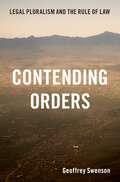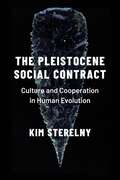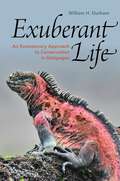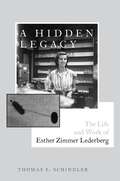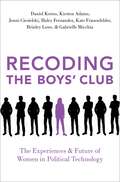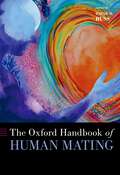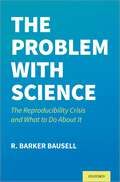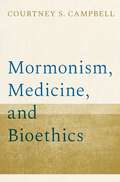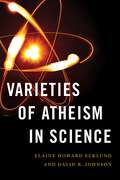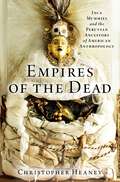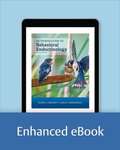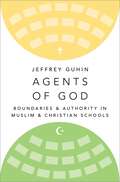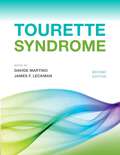- Table View
- List View
Contending Orders: Legal Pluralism and the Rule of Law
by Geoffrey SwensonIn most countries, it is the norm for state courts to operate alongside powerful non-state justice systems, whose roots lie in custom, religion, or tradition. Indeed, non-state justice is frequently the dominant form of legal order. In the developing world, an estimated 80 to 90 percent of disputes are handled outside the state justice system, and nearly all post-conflict states feature extensive legal pluralism because of the weak institutions and contested authority endemic to conflict and post-conflict states. Yet the role of legal pluralism is frequently misunderstood and when different justice systems clash, prolonged, potentially even violent conflict, can result. In Contending Orders, Geoffrey Swenson proposes a new way to understand how state and non-state authorities interact by exploring the full range of legally pluralist environments-combative, competitive, cooperative, and complementary. Drawing upon insights from Afghanistan and Timor-Leste, two countries with extensive legal pluralism, he identifies and critically examines commonly used strategies in legally pluralistic environments. Swenson also illustrates how national and international actors can better engage non-state justice systems. Further, Swenson shows how multiple justice systems can not only co-exist but work together to contribute to the development of a democratic state bound by the rule of law. It is not enough to merely recognize that legal pluralism exists; scholars and policymakers must understand how legal pluralism actually functions. Contending Orders both analyzes the forces that are shaping the relationship between the state and non-state justice worldwide and offers policy strategies to promote the rule of law and good governance wherever legal pluralism thrives.
Contending Orders: Legal Pluralism and the Rule of Law
by Geoffrey SwensonIn most countries, it is the norm for state courts to operate alongside powerful non-state justice systems, whose roots lie in custom, religion, or tradition. Indeed, non-state justice is frequently the dominant form of legal order. In the developing world, an estimated 80 to 90 percent of disputes are handled outside the state justice system, and nearly all post-conflict states feature extensive legal pluralism because of the weak institutions and contested authority endemic to conflict and post-conflict states. Yet the role of legal pluralism is frequently misunderstood and when different justice systems clash, prolonged, potentially even violent conflict, can result. In Contending Orders, Geoffrey Swenson proposes a new way to understand how state and non-state authorities interact by exploring the full range of legally pluralist environments-combative, competitive, cooperative, and complementary. Drawing upon insights from Afghanistan and Timor-Leste, two countries with extensive legal pluralism, he identifies and critically examines commonly used strategies in legally pluralistic environments. Swenson also illustrates how national and international actors can better engage non-state justice systems. Further, Swenson shows how multiple justice systems can not only co-exist but work together to contribute to the development of a democratic state bound by the rule of law. It is not enough to merely recognize that legal pluralism exists; scholars and policymakers must understand how legal pluralism actually functions. Contending Orders both analyzes the forces that are shaping the relationship between the state and non-state justice worldwide and offers policy strategies to promote the rule of law and good governance wherever legal pluralism thrives.
The Pleistocene Social Contract: Culture and Cooperation in Human Evolution
by Kim SterelnyKim Sterelny here builds on his original account of the evolutionary development and interaction of human culture and cooperation, which he first presented in The Evolved Apprentice (2012). Sterelny sees human evolution not as hinging on a single key innovation, but as emerging from a positive feedback loop caused by smaller divergences from other great apes, including bipedal locomotion, better causal and social reasoning, reproductive cooperation, and changes in diet and foraging style. He advances this argument in The Pleistocene Social Contract with four key claims about cooperation, culture, and their interaction in human evolution. First, he proposes a new model of the evolution of human cooperation. He suggests human cooperation began from a baseline that was probably similar to that of great apes, advancing about 1.8 million years ago to an initial phase of cooperative forging, in small mobile bands. Second, he then presents a novel account of the change in evolutionary dynamics of cooperation: from cooperation profits based on collective action and mutualism, to profits based on direct and indirect reciprocation over the course of the Pleistocene. Third, he addresses the question of normative regulation, or moral norms, for band-scale cooperation, and connects it to the stabilization of indirect reciprocation as a central aspect of forager cooperation. Fourth, he develops an account of the emergence of inequality that links inequality to intermediate levels of conflict and cooperation: a final phase of cooperation in largescale, hierarchical societies in the Holocene, beginning about 12,000 years ago. The Pleistocene Social Contract combines philosophy of biology with a reading of the archaeological and ethnographic record to present a new model of the evolution of human cooperation, cultural learning, and inequality.
The Pleistocene Social Contract: Culture and Cooperation in Human Evolution
by Kim SterelnyKim Sterelny here builds on his original account of the evolutionary development and interaction of human culture and cooperation, which he first presented in The Evolved Apprentice (2012). Sterelny sees human evolution not as hinging on a single key innovation, but as emerging from a positive feedback loop caused by smaller divergences from other great apes, including bipedal locomotion, better causal and social reasoning, reproductive cooperation, and changes in diet and foraging style. He advances this argument in The Pleistocene Social Contract with four key claims about cooperation, culture, and their interaction in human evolution. First, he proposes a new model of the evolution of human cooperation. He suggests human cooperation began from a baseline that was probably similar to that of great apes, advancing about 1.8 million years ago to an initial phase of cooperative forging, in small mobile bands. Second, he then presents a novel account of the change in evolutionary dynamics of cooperation: from cooperation profits based on collective action and mutualism, to profits based on direct and indirect reciprocation over the course of the Pleistocene. Third, he addresses the question of normative regulation, or moral norms, for band-scale cooperation, and connects it to the stabilization of indirect reciprocation as a central aspect of forager cooperation. Fourth, he develops an account of the emergence of inequality that links inequality to intermediate levels of conflict and cooperation: a final phase of cooperation in largescale, hierarchical societies in the Holocene, beginning about 12,000 years ago. The Pleistocene Social Contract combines philosophy of biology with a reading of the archaeological and ethnographic record to present a new model of the evolution of human cooperation, cultural learning, and inequality.
Exuberant Life: An Evolutionary Approach to Conservation in Galápagos
by William H. DurhamThe terrestrial organisms of the Galápagos Islands live under conditions unlike those anywhere else. At the edge of a uniquely rich mid-ocean upwelling, their world is also free of mammalian predators and competitors, allowing them to live unbothered, exuberant lives. With its giant tortoises, marine iguanas, flightless cormorants, and forests of giant daisies, there's no question that this is a magnificent place. Long before people traversed the Earth, evolution endowed native species with adaptations to these special conditions and to perturbations like El Niño events and periodic droughts. As the islands have grown ever-more connected with humanity, those same adaptations now make its species vulnerable. Today, the islands are best viewed as one big social-ecological system where the ability of each native organism to survive and reproduce is a product of human activity in addition to ecological circumstances. In this book, William H. Durham takes readers on a tour of Galápagos and the organisms that inhabit these isolated volcanic islands. Exuberant Life offers a contemporary synthesis of what we know about the evolution of its curiously wonderful organisms, how they are faring in the tumultuous changing world around them, and how evolution can guide our efforts today for their conservation. The book highlights the ancestry of a dozen specific organisms in these islands, when and how they made it to the Galápagos, as well as how they have changed in the meantime. Durham traces the strengths and weaknesses of each species, arguing that the mismatch between natural challenges of their habitats and the challenges humans have recently added is the main task facing conservation efforts today. Such analysis often provides surprises and suggestions not yet considered, like the potential benefits to joint conservation efforts between tree finches and tree daisies, or ways in which the peculiar evolved behaviors of Nazca and blue-footed boobies can be used to benefit both species today. In each chapter, a social-ecological systems framework is used to highlight links between human impact, including climate change, and species status today, Historically, the Galápagos have played a central role in our understanding of evolution; what these islands now offer to teach us about conservation may well prove indispensable for the future of the planet.
Exuberant Life: An Evolutionary Approach to Conservation in Galápagos
by William H. DurhamThe terrestrial organisms of the Galápagos Islands live under conditions unlike those anywhere else. At the edge of a uniquely rich mid-ocean upwelling, their world is also free of mammalian predators and competitors, allowing them to live unbothered, exuberant lives. With its giant tortoises, marine iguanas, flightless cormorants, and forests of giant daisies, there's no question that this is a magnificent place. Long before people traversed the Earth, evolution endowed native species with adaptations to these special conditions and to perturbations like El Niño events and periodic droughts. As the islands have grown ever-more connected with humanity, those same adaptations now make its species vulnerable. Today, the islands are best viewed as one big social-ecological system where the ability of each native organism to survive and reproduce is a product of human activity in addition to ecological circumstances. In this book, William H. Durham takes readers on a tour of Galápagos and the organisms that inhabit these isolated volcanic islands. Exuberant Life offers a contemporary synthesis of what we know about the evolution of its curiously wonderful organisms, how they are faring in the tumultuous changing world around them, and how evolution can guide our efforts today for their conservation. The book highlights the ancestry of a dozen specific organisms in these islands, when and how they made it to the Galápagos, as well as how they have changed in the meantime. Durham traces the strengths and weaknesses of each species, arguing that the mismatch between natural challenges of their habitats and the challenges humans have recently added is the main task facing conservation efforts today. Such analysis often provides surprises and suggestions not yet considered, like the potential benefits to joint conservation efforts between tree finches and tree daisies, or ways in which the peculiar evolved behaviors of Nazca and blue-footed boobies can be used to benefit both species today. In each chapter, a social-ecological systems framework is used to highlight links between human impact, including climate change, and species status today, Historically, the Galápagos have played a central role in our understanding of evolution; what these islands now offer to teach us about conservation may well prove indispensable for the future of the planet.
A Hidden Legacy: The Life and Work of Esther Zimmer Lederberg
by Thomas E. SchindlerIt's time to honor the significant scientific contributions of Esther Zimmer Lederberg. In A Hidden Legacy, Thomas E. Schindler shares the story of this remarkable microbiologist and offers insight into why her legacy has been obscured for so long. In the mid-20th century, microbiologist Esther Zimmer Lederberg and her then-husband, Joshua Lederberg, made a series of remarkable discoveries that contributed to the biochemical understanding of the gene. Together, they laid the foundation for molecular biology and the field of bacterial genetics. In 1958, he alone was awarded the Nobel Prize for their work. Esther's ingenuity was largely ignored and undervalued by the Nobel committee and has continued to be obscured by historians of science. In this book, Thomas E. Schindler shares many of Esther's hidden scientific contributions and her role in the discoveries that launched her then-husband's celebrated career. A Hidden Legacy delves into how, as a couple, the Lederbergs established a new field of bacterial genetics in the decade leading up to the discovery of the DNA double helix. Their impressive series of achievements includes the discovery of: *l bacteriophage and the first plasmid, known as the F-factor; how viruses carry bacterial genes between bacteria; and fundamental properties of bacterial sex. Schindler explains how Esther's research revealed unique features of bacterial sex that are now essential to our understanding of molecular biology and evolution. A magnificent story of a remarkable scientist, A Hidden Legacy takes readers through the process that scrambled the tree of life and offers insight into the role Esther played in uncovering these secretes of bacterial and viral genes.
A Hidden Legacy: The Life and Work of Esther Zimmer Lederberg
by Thomas E. SchindlerIt's time to honor the significant scientific contributions of Esther Zimmer Lederberg. In A Hidden Legacy, Thomas E. Schindler shares the story of this remarkable microbiologist and offers insight into why her legacy has been obscured for so long. In the mid-20th century, microbiologist Esther Zimmer Lederberg and her then-husband, Joshua Lederberg, made a series of remarkable discoveries that contributed to the biochemical understanding of the gene. Together, they laid the foundation for molecular biology and the field of bacterial genetics. In 1958, he alone was awarded the Nobel Prize for their work. Esther's ingenuity was largely ignored and undervalued by the Nobel committee and has continued to be obscured by historians of science. In this book, Thomas E. Schindler shares many of Esther's hidden scientific contributions and her role in the discoveries that launched her then-husband's celebrated career. A Hidden Legacy delves into how, as a couple, the Lederbergs established a new field of bacterial genetics in the decade leading up to the discovery of the DNA double helix. Their impressive series of achievements includes the discovery of: *l bacteriophage and the first plasmid, known as the F-factor; how viruses carry bacterial genes between bacteria; and fundamental properties of bacterial sex. Schindler explains how Esther's research revealed unique features of bacterial sex that are now essential to our understanding of molecular biology and evolution. A magnificent story of a remarkable scientist, A Hidden Legacy takes readers through the process that scrambled the tree of life and offers insight into the role Esther played in uncovering these secretes of bacterial and viral genes.
Recoding the Boys' Club: The Experiences and Future of Women in Political Technology
by Daniel Kreiss Kirsten Adams Jenni Ciesielski Haley Fernandez Kate Frauenfelder Brinley Lowe Gabrielle MicchiaThe #MeToo movement has catalyzed an international discussion about the routine challenges women face in their professional lives as a result of male-dominated industries and office cultures. These include well-documented cases of sexual harassment and assault, but also unequal opportunities, unequal pay, sexist stereotypes, and a devaluation of women's labor. While these are problems women face in all industries and at all levels, the political and technology sectors are particularly rife with them. Recoding the Boys' Club is a ground-breaking deep-dive into the work experiences of women in the political technology field in the United States. Political technology sits at the intersection of two fields dominated by men--politics and technology--and has become a cornerstone of operations in political campaigns and political institutions more generally. Drawing on a unique dataset of 1004 staffers working in political technology on presidential campaigns from 2004-2016, analysis of hiring patterns during the 2020 presidential primary cycle, and interviews with 45 women who worked on 12 different presidential campaigns, this book reveals the underrepresentation of women in political technology, especially leadership positions, as well as the struggle women face to have their voices heard within the "boys' clubs" and "bro cultures" of political technology. It chronicles the gendered expectations women face to provide emotional labor, stereotypes about women's competencies that shape their opportunities, the ways in which women's ideas are discredited, and the formal and informal forms of exclusion in campaign culture--leading to widespread feelings of "imposter syndrome" among women in this environment. These issues are often compounded by a mentality that the well-being of staffers must come secondary to the goals of the campaign, despite what campaigns might profess publically about gender and labor. Since these campaigns are important entry and training points for the wider field of political technology, the gendered inequities encountered within them have implications for women's professional experiences and careers long after campaigns have ended. This book aims to help political practitioners create more gender equitable and inclusive workplaces, ones that value the ideas and skills of all those who work to get candidates elected.
RECODING THE BOYS' CLUB OSDP C: The Experiences and Future of Women in Political Technology
by Kirsten Adams Daniel Kreiss Jenni Ciesielski Haley Fernandez Kate Frauenfelder Brinley Lowe Gabrielle MicchiaThe #MeToo movement has catalyzed an international discussion about the routine challenges women face in their professional lives as a result of male-dominated industries and office cultures. These include well-documented cases of sexual harassment and assault, but also unequal opportunities, unequal pay, sexist stereotypes, and a devaluation of women's labor. While these are problems women face in all industries and at all levels, the political and technology sectors are particularly rife with them. Recoding the Boys' Club is a ground-breaking deep-dive into the work experiences of women in the political technology field in the United States. Political technology sits at the intersection of two fields dominated by men--politics and technology--and has become a cornerstone of operations in political campaigns and political institutions more generally. Drawing on a unique dataset of 1004 staffers working in political technology on presidential campaigns from 2004-2016, analysis of hiring patterns during the 2020 presidential primary cycle, and interviews with 45 women who worked on 12 different presidential campaigns, this book reveals the underrepresentation of women in political technology, especially leadership positions, as well as the struggle women face to have their voices heard within the "boys' clubs" and "bro cultures" of political technology. It chronicles the gendered expectations women face to provide emotional labor, stereotypes about women's competencies that shape their opportunities, the ways in which women's ideas are discredited, and the formal and informal forms of exclusion in campaign culture--leading to widespread feelings of "imposter syndrome" among women in this environment. These issues are often compounded by a mentality that the well-being of staffers must come secondary to the goals of the campaign, despite what campaigns might profess publically about gender and labor. Since these campaigns are important entry and training points for the wider field of political technology, the gendered inequities encountered within them have implications for women's professional experiences and careers long after campaigns have ended. This book aims to help political practitioners create more gender equitable and inclusive workplaces, ones that value the ideas and skills of all those who work to get candidates elected.
The Oxford Handbook of Human Mating
by David M. BussThe scientific study of human mating has mushroomed over the past three decades, and this growth in turn has generated a proliferation of evolving literature revealing fresh discoveries about mate attraction, mate choice, mate retention, marital satisfaction, jealousy, infidelity, intimate partner violence, breakups, internet dating, cyberstalking, and sexual coercion. In The Oxford Handbook of Human Mating, editor David M. Buss showcases contributions from "the best and the brightest" scientists in the field, providing up-to-date summaries of theories and empirical evidence of the science of human mating strategies. Much of the research in the field is guided by sexual selection theory. Over 150 years after Darwin's proposal of sexual selection theory, it has become the most important overarching theoretical framework for the scientific study of the mating strategies of all sexually reproducing species, including humans. A mountain of research centered around Darwin's classic book has documented the many complexities of human mate competition and mate choice; how these processes differ between the sexes; and how they differ as a function of sex ratio, mate value, social contexts, ovulation cycles, personality characteristics, and cultural norms and mating rituals. Thus, the science is now ripe for a collection of work by eminent scholars in the field. David M. Buss is a leading researcher and pioneer in the study of human mating strategies, and he applies his expertise to the curation of this volume, which includes major sections covering theories of human mating; mate selection and mate attraction; mate competition; sexual conflict in mating; human pair bonding; the endocrinology of mating; and mating in the modern world.
The Oxford Handbook of Human Mating
by David M. BussThe scientific study of human mating has mushroomed over the past three decades, and this growth in turn has generated a proliferation of evolving literature revealing fresh discoveries about mate attraction, mate choice, mate retention, marital satisfaction, jealousy, infidelity, intimate partner violence, breakups, internet dating, cyberstalking, and sexual coercion. In The Oxford Handbook of Human Mating, editor David M. Buss showcases contributions from "the best and the brightest" scientists in the field, providing up-to-date summaries of theories and empirical evidence of the science of human mating strategies. Much of the research in the field is guided by sexual selection theory. Over 150 years after Darwin's proposal of sexual selection theory, it has become the most important overarching theoretical framework for the scientific study of the mating strategies of all sexually reproducing species, including humans. A mountain of research centered around Darwin's classic book has documented the many complexities of human mate competition and mate choice; how these processes differ between the sexes; and how they differ as a function of sex ratio, mate value, social contexts, ovulation cycles, personality characteristics, and cultural norms and mating rituals. Thus, the science is now ripe for a collection of work by eminent scholars in the field. David M. Buss is a leading researcher and pioneer in the study of human mating strategies, and he applies his expertise to the curation of this volume, which includes major sections covering theories of human mating; mate selection and mate attraction; mate competition; sexual conflict in mating; human pair bonding; the endocrinology of mating; and mating in the modern world.
The Problem with Science: The Reproducibility Crisis and What to do About It
by R. Barker BausellRecent events have vividly underscored the societal importance of science, yet the majority of the public are unaware that a large proportion of published scientific results are simply wrong. The Problem with Science is an exploration of the manifestations and causes of this scientific crisis, accompanied by a description of the very promising corrective initiatives largely developed over the past decade to stem the spate of irreproducible results that have come to characterize many of our sciences. More importantly, Dr. R. Barker Bausell has designed it to provide guidance to practicing and aspiring scientists regarding how (a) to change the way in which science has come to be both conducted and reported in order to avoid producing false positive, irreproducible results in their own work and (b) to change those institutional practices (primarily but not exclusively involving the traditional journal publishing process and the academic reward system) that have unwittingly contributed to the present crisis. There is a need for change in the scientific culture itself. A culture which prioritizes conducting research correctly in order to get things right rather than simply getting it published.
The Problem with Science: The Reproducibility Crisis and What to do About It
by R. Barker BausellRecent events have vividly underscored the societal importance of science, yet the majority of the public are unaware that a large proportion of published scientific results are simply wrong. The Problem with Science is an exploration of the manifestations and causes of this scientific crisis, accompanied by a description of the very promising corrective initiatives largely developed over the past decade to stem the spate of irreproducible results that have come to characterize many of our sciences. More importantly, Dr. R. Barker Bausell has designed it to provide guidance to practicing and aspiring scientists regarding how (a) to change the way in which science has come to be both conducted and reported in order to avoid producing false positive, irreproducible results in their own work and (b) to change those institutional practices (primarily but not exclusively involving the traditional journal publishing process and the academic reward system) that have unwittingly contributed to the present crisis. There is a need for change in the scientific culture itself. A culture which prioritizes conducting research correctly in order to get things right rather than simply getting it published.
Mormonism, Medicine, and Bioethics
by Courtney S. CampbellMormonism, Medicine, and Bioethics provides the first comprehensive treatment of principles and positions on questions of bioethics encountered by members, professionals, and ecclesiastical leaders of The Church of Jesus Christ of Latter-day Saints (LDS or Mormon). The book addresses three fundamental features of a coherent religious bioethics: precepts for practical decision-making, general ethical principles, and core religious convictions that give a distinctive motivation for personal, communal, and professional integrity. LDS ethical principles of love, hospitality to strangers, covenantal solidarity, justice, and moral agency are integrated with central topics in bioethics including abortion, genetic testing and enhancements, in vitro fertilization, medical assisted death, medicinal marijuana, neonatal intensive care, organ donation, preventive health care, universal access to care, and vaccinations. This book uses first-person experiences to give voice to the lived moral realities of Latter-day Saints as they experience difficult and wrenching ethical questions and choices as persons, family members, community members, professionals, and as citizens within the context of their distinctive faith convictions. It situates these communal conversations within the broader discourse of bioethics and thereby supports both bioethics and religious literacy. Mormonism, Medicine, and Bioethics also examines circumstances in which The Church of Jesus Christ of Latter-day Saints engages in a moral witness of its values on matters of public policy, such as legalization of physician-assisted death, of elective abortion, and of medicinal marijuana. The book concludes with a distinctive normative argument on why LDS ethical principles and practices require support of universal access to an adequate level of health care for all persons. It provides an appendix of significant LDS ecclesiastical policies on medical, health, and moral issues, making it a definitive educational and reference compilation.
Mormonism, Medicine, and Bioethics
by Courtney S. CampbellMormonism, Medicine, and Bioethics provides the first comprehensive treatment of principles and positions on questions of bioethics encountered by members, professionals, and ecclesiastical leaders of The Church of Jesus Christ of Latter-day Saints (LDS or Mormon). The book addresses three fundamental features of a coherent religious bioethics: precepts for practical decision-making, general ethical principles, and core religious convictions that give a distinctive motivation for personal, communal, and professional integrity. LDS ethical principles of love, hospitality to strangers, covenantal solidarity, justice, and moral agency are integrated with central topics in bioethics including abortion, genetic testing and enhancements, in vitro fertilization, medical assisted death, medicinal marijuana, neonatal intensive care, organ donation, preventive health care, universal access to care, and vaccinations. This book uses first-person experiences to give voice to the lived moral realities of Latter-day Saints as they experience difficult and wrenching ethical questions and choices as persons, family members, community members, professionals, and as citizens within the context of their distinctive faith convictions. It situates these communal conversations within the broader discourse of bioethics and thereby supports both bioethics and religious literacy. Mormonism, Medicine, and Bioethics also examines circumstances in which The Church of Jesus Christ of Latter-day Saints engages in a moral witness of its values on matters of public policy, such as legalization of physician-assisted death, of elective abortion, and of medicinal marijuana. The book concludes with a distinctive normative argument on why LDS ethical principles and practices require support of universal access to an adequate level of health care for all persons. It provides an appendix of significant LDS ecclesiastical policies on medical, health, and moral issues, making it a definitive educational and reference compilation.
Varieties of Atheism in Science
by Elaine Howard Ecklund David R. JohnsonA significant number of Americans view atheists as immoral elitists, aloof and unconcerned with the common good, and they view science and scientists as responsible. Thanks in large part to the prominence and influence of New Atheists such as Richard Dawkins, Sam Harris, Daniel Dennett, and Christopher Hitchens, New Atheism has claimed the pulpit of secularity in Western society. New Atheists have given voice to marginalized nonreligious individuals and underscored the importance of science in society. They have also advanced a derisive view of religion and forcefully argued that science and religion are intrinsically in conflict. Many in the public around the globe think that all scientists are atheists and that all atheist scientists are New Atheists, militantly against religion and religious people. But what do everyday atheist scientists actually think about religion? Drawing on a survey of 1,293 atheist scientists in the U.S. and U.K., and 81 in-depth interviews, this book explains the pathways that led to atheism among scientists, the diverse views of religion they hold, their perspectives on the limits to what science can explain, and their views of meaning and morality. The findings reveal a vast gulf between the rhetoric of New Atheism in the public sphere and the reality of atheism in science. The story of the varieties of atheism in science is consequential for both scientific and religious communities and points to tools for dialogue between these seemingly disparate groups.
Varieties of Atheism in Science
by David R. Johnson Elaine Howard EcklundA significant number of Americans view atheists as immoral elitists, aloof and unconcerned with the common good, and they view science and scientists as responsible. Thanks in large part to the prominence and influence of New Atheists such as Richard Dawkins, Sam Harris, Daniel Dennett, and Christopher Hitchens, New Atheism has claimed the pulpit of secularity in Western society. New Atheists have given voice to marginalized nonreligious individuals and underscored the importance of science in society. They have also advanced a derisive view of religion and forcefully argued that science and religion are intrinsically in conflict. Many in the public around the globe think that all scientists are atheists and that all atheist scientists are New Atheists, militantly against religion and religious people. But what do everyday atheist scientists actually think about religion? Drawing on a survey of 1,293 atheist scientists in the U.S. and U.K., and 81 in-depth interviews, this book explains the pathways that led to atheism among scientists, the diverse views of religion they hold, their perspectives on the limits to what science can explain, and their views of meaning and morality. The findings reveal a vast gulf between the rhetoric of New Atheism in the public sphere and the reality of atheism in science. The story of the varieties of atheism in science is consequential for both scientific and religious communities and points to tools for dialogue between these seemingly disparate groups.
World on Fire: Humans, Animals, and the Future of the Planet
by Mark RowlandsMark Rowlands presents a novel analysis of three epoch-defining environmental problems: climate, extinction, and pestilence. Our climate is changing at a rate that is unprecedented and, if unchecked, disastrous. Species are disappearing hundreds or thousands of times faster than normal. COVID-19 has wreaked social and economic havoc but is merely the latest off a blossoming production line of emerging infectious diseases, many of which have the potential to be far worse. Rowlands establishes that all three problems are consequences of choices we have made about energy, which can be divided into two major forms: fuel and food. Focusing on food choices as far more central to the issue than commonly recognized, he argues that the solution is breaking our collective habit of eating animals. Rowlands shows that in doing so, we stem our insatiable hunger for land, which he identifies as central to the problems of extinction and pestilence. He explains that reversing the industrial farming of animals for food will first, substantially cut climate emissions, rapidly enough to allow sustainable energy technologies time to become viable alternatives; and most importantly, make vast areas of a land available for the kind of aggressive afforestation policy that he shows as necessary to bring all three problems under control. With World on Fire, Mark Rowlands identifies the source of our environmental ills and provides a compelling and accessible account of how to solve them.
World on Fire: Humans, Animals, and the Future of the Planet
by Mark RowlandsMark Rowlands presents a novel analysis of three epoch-defining environmental problems: climate, extinction, and pestilence. Our climate is changing at a rate that is unprecedented and, if unchecked, disastrous. Species are disappearing hundreds or thousands of times faster than normal. COVID-19 has wreaked social and economic havoc but is merely the latest off a blossoming production line of emerging infectious diseases, many of which have the potential to be far worse. Rowlands establishes that all three problems are consequences of choices we have made about energy, which can be divided into two major forms: fuel and food. Focusing on food choices as far more central to the issue than commonly recognized, he argues that the solution is breaking our collective habit of eating animals. Rowlands shows that in doing so, we stem our insatiable hunger for land, which he identifies as central to the problems of extinction and pestilence. He explains that reversing the industrial farming of animals for food will first, substantially cut climate emissions, rapidly enough to allow sustainable energy technologies time to become viable alternatives; and most importantly, make vast areas of a land available for the kind of aggressive afforestation policy that he shows as necessary to bring all three problems under control. With World on Fire, Mark Rowlands identifies the source of our environmental ills and provides a compelling and accessible account of how to solve them.
Empires of the Dead: Inca Mummies and the Peruvian Ancestors of American Anthropology
by Christopher HeaneyWhen the Smithsonian's Hall of Physical Anthropology opened in 1965 it featured 160 Andean skulls affixed to a wall to visualize how the world's human population had exploded since the birth of Christ. Through a history of Inca mummies, a pre-Hispanic surgery called trepanation, and Andean crania like these, Empires of the Dead explains how "ancient Peruvians" became the single largest population in the Smithsonian and many other museums in Peru, the Americas, and beyond. In 1532, when Spain invaded the Inca empire, Europeans learned that Inca and Andean peoples made their ancestors sacred by preserving them with the world's oldest practices of artificial mummification. To extinguish their power, the Spaniards collected these ancestors as specimens of conquest, science, nature, and race. Yet colonial Andean communities also found ways to keep the dead alive, making "Inca mummies" a symbol of resistance that Spanish American patriots used to introduce Peruvian Independence and science to the world. Inspired, nineteenth-century US anthropologists disinterred and collected Andean mummies and skulls to question the antiquity and civilization of the American "race" in publications, world's fairs, and US museums. Peruvian scholars then used those mummies and skulls to transform anthropology itself, curating these "scientific ancestors" as evidence of pre-Hispanic superiority in healing. Bringing together the history of science, race, and museums' possession of Indigenous remains, from the sixteenth century to the twentieth, Empires of the Dead illuminates how South American ancestors became coveted mummies, skulls, and specimens of knowledge and nationhood. In doing so it reveals how Peruvian and Andean peoples have learned from their dead, seeking the recovery of looted heritage in the centuries before North American museums began their own work of decolonization.
Empires of the Dead: Inca Mummies and the Peruvian Ancestors of American Anthropology
by Christopher HeaneyWhen the Smithsonian's Hall of Physical Anthropology opened in 1965 it featured 160 Andean skulls affixed to a wall to visualize how the world's human population had exploded since the birth of Christ. Through a history of Inca mummies, a pre-Hispanic surgery called trepanation, and Andean crania like these, Empires of the Dead explains how "ancient Peruvians" became the single largest population in the Smithsonian and many other museums in Peru, the Americas, and beyond. In 1532, when Spain invaded the Inca empire, Europeans learned that Inca and Andean peoples made their ancestors sacred by preserving them with the world's oldest practices of artificial mummification. To extinguish their power, the Spaniards collected these ancestors as specimens of conquest, science, nature, and race. Yet colonial Andean communities also found ways to keep the dead alive, making "Inca mummies" a symbol of resistance that Spanish American patriots used to introduce Peruvian Independence and science to the world. Inspired, nineteenth-century US anthropologists disinterred and collected Andean mummies and skulls to question the antiquity and civilization of the American "race" in publications, world's fairs, and US museums. Peruvian scholars then used those mummies and skulls to transform anthropology itself, curating these "scientific ancestors" as evidence of pre-Hispanic superiority in healing. Bringing together the history of science, race, and museums' possession of Indigenous remains, from the sixteenth century to the twentieth, Empires of the Dead illuminates how South American ancestors became coveted mummies, skulls, and specimens of knowledge and nationhood. In doing so it reveals how Peruvian and Andean peoples have learned from their dead, seeking the recovery of looted heritage in the centuries before North American museums began their own work of decolonization.
An Introduction To Behavioral Endocrinology
by Randy Joe Nelson Lance J. Kriegsfeld"A market-leading text, An Introduction to Behavioral Endocrinology, Sixth Edition, provides an updated, integrated presentation of the study of hormone-behavior-brain interactions. Maintaining a comparative approach, the text explores the endocrine mechanisms that have evolved in both human and nonhuman animals to solve common problems in survival and reproduction"--
Agents of God: Boundaries and Authority in Muslim and Christian Schools
by Jeffrey GuhinSociologist Jeffrey Guhin spent a year and a half embedded in four high schools in the New York City area -- two of them Sunni Muslim and two Evangelical Christian. At first pass, these communities do not seem to have much in common. But under closer inspection Guhin finds several common threads: each school community holds to a conservative approach to gender and sexuality, a hostility towards the theory of evolution, and a deep suspicion of secularism. All possess a double-sided image of America, on the one hand as a place where their children can excel and prosper, and on the other hand as a land of temptations that could lead their children astray. He shows how these school communities use boundaries of politics, gender, and sexuality to distinguish themselves from the secular world, both in school and online. Guhin develops his study of boundaries in the book's first half to show how the school communities teach their children who they are not; the book's second half shows how the communities use "external authorities" to teach their children who they are. These "external authorities" -- such as Science, Scripture, and Prayer -- are experienced by community members as real powers with the ability to issue commands and coerce action. By offloading agency to these external authorities, leaders in these schools are able to maintain a commitment to religious freedom while simultaneously reproducing their moral commitments in their students. Drawing on extensive classroom observation, community participation, and 143 formal interviews with students, teachers, and staff, this book makes an original contribution to sociology, religious studies, and education.
Tourette Syndrome
by Davide Martino James LeckmanTourette syndrome (TS) has become increasingly recognised within society and has gained scientific interest worldwide. Knowledge of its clinical presentation, mechanisms of disease, and available treatment approaches has increased remarkably over the last two decades. Likewise, the way clinicians, teachers, social care workers, and families face the problems manifested by patients with TS is rapidly evolving. Tourette Syndrome, edited by Davide Martino and James F. Leckman, offers a unique opportunity to capture this knowledge advance through a comprehensive and up-to-date overview. Tourette Syndrome covers all the main aspects related to TS, analyzing its complex clinical presentation, the novel viewpoints of causes and mechanisms, state-of-the-art assessment techniques, and the diversity of treatment options. Multidisciplinarity is the main asset of this volume, which represents a source of consultation for a wide audience of professionals, integrated with video tutorials related to particularly complex areas of patient management. Medical and PhD students, as well as post-doctoral scientists, will be able to use the volume as a valuable learning source.
